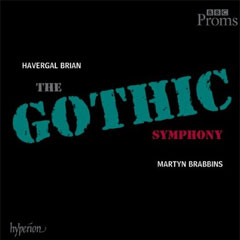Havergal Brian’s Gothic Symphony: Additions &
Corrections
by Richard Freed | April 12,
2012
 wo weeks
after my
review of the Hyperion release of Havergal Brian’s Gothic Symphony was posted,
Mike Le Voi wrote to me from Australia to offer some corrections, primarily on the matter
of the work’s performance history. Mr. Le Voi, of the 4MBS Concert Recording Team, is
especially knowledgeable on this work by virtue of his hands-on experience in producing
4MBS Classic FM’s live broadcast of its first concert performance outside the UK,
which took place in Brisbane, Australia, with specially assembled forces conducted by John
Curro, on December 22, 2010, seven months before the London Proms performance preserved on
the Hyperion CDs. wo weeks
after my
review of the Hyperion release of Havergal Brian’s Gothic Symphony was posted,
Mike Le Voi wrote to me from Australia to offer some corrections, primarily on the matter
of the work’s performance history. Mr. Le Voi, of the 4MBS Concert Recording Team, is
especially knowledgeable on this work by virtue of his hands-on experience in producing
4MBS Classic FM’s live broadcast of its first concert performance outside the UK,
which took place in Brisbane, Australia, with specially assembled forces conducted by John
Curro, on December 22, 2010, seven months before the London Proms performance preserved on
the Hyperion CDs.
In respect to other performances prior to those two,
there were indeed very few, but not quite as few as I may suggested in my review. Mr. Le
Voi kindly referred me to the
Havergal Brian website, which offers five pages of comprehensive details on them as
well as on recordings, articles and reviews relating to this work, showing that there were
seven performances before the one in Australia, differing in their respective levels of
professionalism as well as in their actual substance. Some were complete, while others
were of Part I alone, an option sanctioned by the composer. Some were public concerts,
while others were not, and one took form in recording sessions under studio conditions.
Here is a rundown of all performances to date:
June 24, 1961 – World premiere, at Central Hall,
Westminster, London. Professional singers with instrumental ensembles drawn mostly from
schools, conducted by Bryan Fairfax.
October 30, 1966 – First professional performance,
Royal Albert Hall, London. BBC Symphony Orchestra with soloists and choruses, under Sir
Adrian Boult. Broadcast live by BBC. Recording issued in 2009, Testament set SBT2 1454.
October 10, 1976 – Part I only, for an invited
audience, Royal Albert Hall. New Philharmonia Orchestra conducted by Sir Charles Groves.
Broadcast live, BBC.
May 21, 1978 – Victoria Hall, Hanley, UK. Ad hoc
orchestra, with soloists and choruses, conducted by Trevor Stokes.
May 25, 1980 – Royal Albert Hall. Ole Schmidt
conducting the London Symphony Orchestra, with soloists and choruses. Broadcast by BBC.
September 15, 1984 – St Olave’s School,
Orpington, UK – Public rehearsal of Part I only. Ad hoc orchestra conducted by Marc
Fitzgerald.
March 29-31 and October 16-22, 1989 – Bratislava,
Slovak Republic. Recording sessions, Ondrej Lenard conducting CSR Symphony Orchestra, with
soloists and choruses. Recording (the only one so far made under studio conditions)
released by Marco Polo in 1989, subsequently reissued as Naxos 8.557418-419.
December 22, 2010 – Queensland Performing Arts
Centre, Brisbane, Australia. John Curro conducting specially assembled Gothic Symphony
Orchestra and choruses, with soloists. First concert performance outside the UK; first
anywhere since 1980. Broadcast by 4MBS Classic FM.
July 17, 2011 – Royal Albert Hall. Proms performance
conducted by Martyn Brabbins. Broadcast by the BBC, issued on CD by Hyperion.
Mike Le Voi observes that this Proms recording appears to
have been recorded by the BBC, and not by Hyperion’s own recording team, which I
congratulated in my review. Most instructively, for me, Mr. Le Voi has provided definitive
validation of the layout of the Hyperion CDs. I had complained that if Hyperion had not
included the eight and a half minutes of applause and cheering that followed the Proms
performance, all three sections of Part II could have been accommodated on the second
disc, instead of splitting Part II between the two CDs. The point here, as Mr. Le Voi
notes, is that Parts I and II are directly conjoined in the score:
"The problem with putting all three sections of Part
II on the second CD is that movements 2, 3 and 4 (i.e., the last two movements of
Part I and the first one of Part II) all segue into one another. It would produce a very
disjointed experience if you had to get up and change the CD as Part II started [because
there is no break in the music at that point]. That is why both Naxos and Hyperion have
movements 1-4 on CD 1 and movements 5-6 on CD 2. Brian wrote an "ending chord"
for use when Part I is performed on its own. This is not the same as the chord that opens
Part II. The only public performance in which both chords were used was the one conducted
by John Curro in 2010, as he took a five-minute pause between Part I and Part II. Thus, in
my production of the 2010 concert for broadcast, CD 1 is 37 minutes long and CD 2 is 69
minutes long. This is, of course, lopsided, but it is a true representation of what took
place that day. With Brabbins in 2011, the choirs all stood up just before the end of Part
I, with gasps from the audience, and the segue was used."
Thus the performance recorded by Mr. Le Voi actually does
provide a space between Parts I and II, and this is reflected in his disc layout. His 4MBS
recording of the Australian concert has not been made available on commercial CD so far. |

 wo weeks
after
wo weeks
after